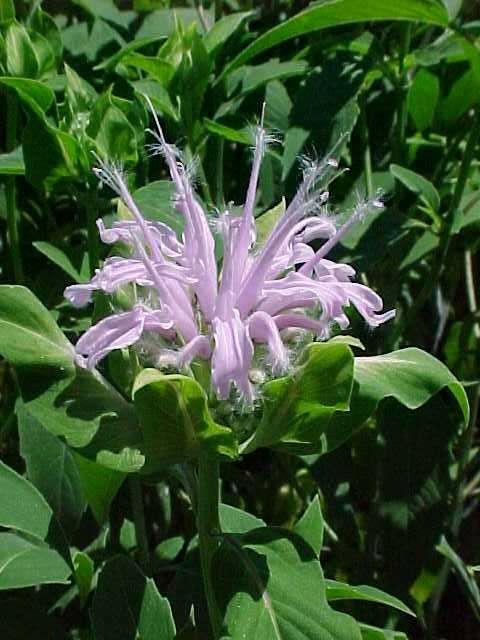Wild bergamot (Monarda fistulosa)
Wild bergamot
Monarda fistulosa, commonly called wild bergamot, is a common Missouri native perennial which occurs statewide in dryish soils on prairies, dry rocky woods and glade margins, unplanted fields and along roads and railroads. A clump-forming, mint family member that grows typically to 2-4′ tall. Lavender, two-lipped, tubular flowers appear in dense, globular, solitary, terminal heads atop square stems. Each flower head is subtended by (rests upon) a whorl of showy, pinkish, leafy bracts. Flowers are attractive to bees and butterflies. The toothed, aromatic, oblong, grayish-green leaves (to 4″) may be used in teas. Long summer bloom period.
Genus name honors Nicholas Monardes (1493-158- , physician and botanist of Seville.
Specific epithet means hollow like a pipe.

Best grown in dry to medium moisture, well-drained soils in full sun to part shade. Tolerates somewhat poor soils and some drought. Plants need good air circulation. Deadhead flowers to prolong summer bloom. Tends to self-seed.
| Hardiness zone | 3 - 9 |
| Sun light | Full sun to part shade |
| Water | Dry to medium |
| Maintenance | Medium |
Powdery mildew can be a significant problem with the monardas, particularly in crowded gardens with poor air circulation. This species has good mildew resistance, however. Rust can also be a problem.
Provides color and contrast for the herb garden, wild garden, native plant garden, meadow or naturalized area. May be used in the perennial border, but is simply a less colorful selection than the similar-in-appearance Monarda didyma and its many cultivars (the beebalms).
| Common name | Wild bergamot |
| Botanical name | Monarda fistulosa |
| Plant type | Herbaceous perennial |
| Family | Lamiaceae |
| Hardiness zone | 3 - 9 |
| Water | Dry to medium |
| Maintenance | Medium |
| Flower color | Pink/lavender |
| Flowering period | July - September |
| Height | 2 - 4 ft. |
| Width | 2 - 3 ft. |